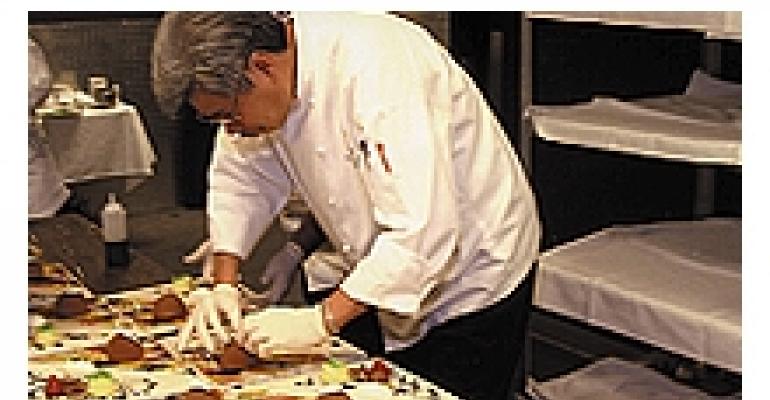
PERFECT presentation and fantastic fare may be the hallmarks of formal events, but that doesn't mean that these fêtes can't be fun, too. From a nine-course Chinese New Year's celebration to a benefit dinner that let guests dine through the decades, catering experts discuss the latest trends in formal dinners.
FARE GAME
“I definitely think that in today's society, gone are the days of very stuffy types of affairs, and that extends to menus, too,” says Gary McCreary, CMP, executive director of catering and convention services at the Venetian Resort-Hotel-Casino in Las Vegas. “More and more, people are incorporating fun elements into what in the past would have been very formal banquets.” He notes for dishes being served at today's formal events, “People are a little more adventurous — we're serving a lot of items that in the past would have been considered exotic things that clients wouldn't try for large, formal events, like buffalo and Tasmanian trout.”

Plated dinners remain the rule for his formal dinners, McCreary says, and while the cuisine is more adventurous, service must remain flawless. “The biggest thing to watch out for when doing formal dinners is the service factor, making sure that the timing is right on,” he notes. For a nine-course Chinese New Year's banquet for 600 of the Venetian's Asian clients, the meal featured authentic ingredients — including shark fins and bird's nests — that were flown in from China for the event. “The ingredients alone in a formal meal can be very expensive, and if you don't serve dishes at the right time, there can be quality reductions,” McCreary explains.
Ensuring superb service often means bringing in extra staff, which holds true for small events as well as large ones. For an event with a “Feast of the Doge” theme, the Venetian banqueting staff re-created a 17th century feast that was served by 32 costumed servers — one for each of the 32 guests.
SERVICE INDUSTRY
Even if an event is formal, more-casual presentation styles can still be on the menu. “Formal no longer necessarily means butlered hors d'oeuvre and a seated, plated dinner,” notes Jasmine Huffman, marketing manager at Chicago-based Blue Plate Catering. “Stations have become popular for formal events because they allow clients to serve a variety of items, and they also get people moving around and mingling. People are leaning towards creative and themed dinners — when a client wants something formal, it typically means a higher level of service.”
For the 50th anniversary of WTTW, Chicago's public television station, Blue Plate served a buffet-style dinner that let the 500 guests sample popular dishes from the last 50 years.
Iceberg lettuce wedges with Thousand Island dressing and classic meatloaf with ketchup represented the 1950s, while 1960s items included heirloom tomato gazpacho and vichyssoise. Wisconsin cheddar fondue served with sliced bratwursts, sourdough squares and roasted fingerling potatoes re-created the fondue craze of the '70s, grilled sirloin served atop sun-dried tomato risotto evoked the '80s, and pistachio-and-molasses-roasted salmon with Israeli couscous recalled the health-conscious '90s. A combination of passed and plated desserts provided different presentation options for the final course. “If a client really wants a traditional, formal dinner, we have noticed a greater willingness to experiment with different serving styles using unique vessels, such as a wooden tray with three small plates for three different items,” Huffman says.
FOOD FACTOR
Chris Siversen, executive chef at Twenty Four Fifth and Bridgewaters, two New York event spaces owned by The Glazier Group, notes more demand for organic ingredients at formal events. “People ask about where the meat is coming from — they ask if it is organic or top-quality meat,” he says, citing TV's Food Network and the celebrity parties seen on E and in InStyle magazine as the sources of clients' increased food awareness.
For a 60-guest wedding reception for one food-loving couple, Siversen created a formal dinner menu that included seven courses instead of the usual three or four. “All they really wanted for the party was to enjoy the chef's tasting menu — they never even got up to dance,” he says. The menu included a Maine lobster, spinach gnocchi and saffron bourride, slow-roasted poussin with poussin confit dumplings, and chilled autumn fruit soup; each course was paired with a different wine. Naturally, the labor-intensive event required more hands to do the work. “{The couple} was very particular about the silverware and china used — each course had a different {pattern} of china, and the tables were larger tables because of all the food,” Siversen says. The silverware had to be changed constantly, as did the wine glasses, “which created so much work.” But in spite of the increased staff for formal events, “I don't think formality [has to be] stuffy — I think the wait staff creates the equation,” he explains. “If the service has a comfortable approach, it will make the guests feel comfortable.”
RESOURCES
Blue Plate, 312/421-6666; The Glazier Group, 212/608-7400; The Venetian Resort-Hotel-Casino, 702/414-400





